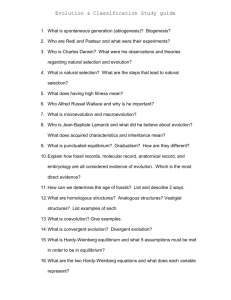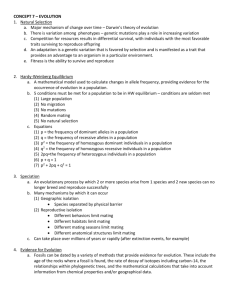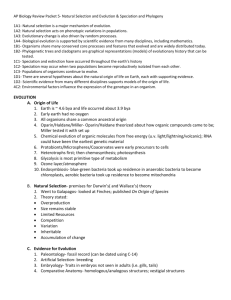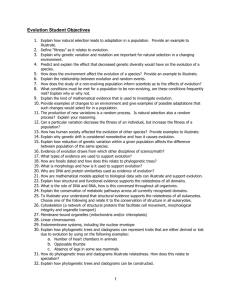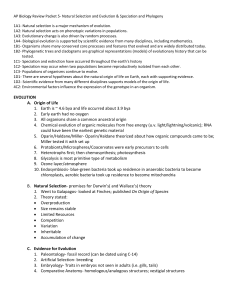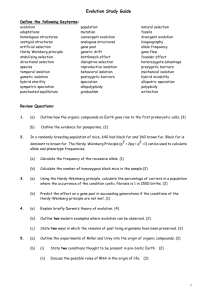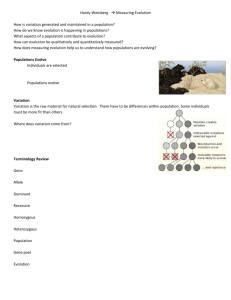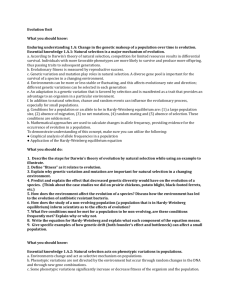CONCEPT 7 – EVOLUTION Natural Selection Major mechanism of
advertisement
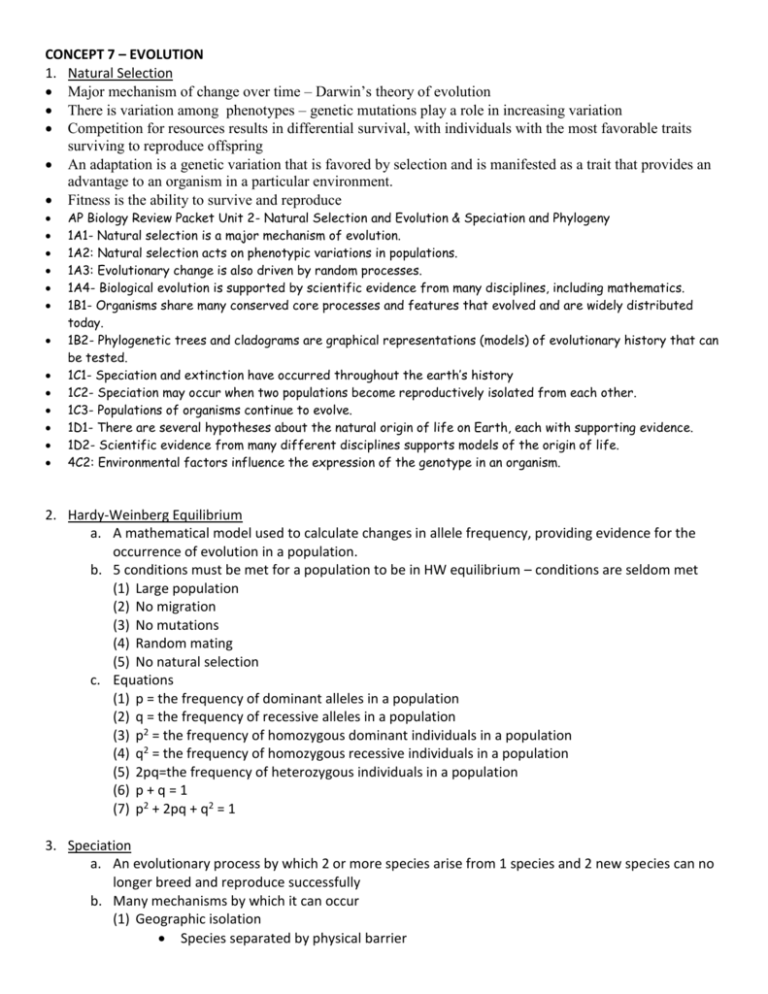
CONCEPT 7 – EVOLUTION 1. Natural Selection Major mechanism of change over time – Darwin’s theory of evolution There is variation among phenotypes – genetic mutations play a role in increasing variation Competition for resources results in differential survival, with individuals with the most favorable traits surviving to reproduce offspring An adaptation is a genetic variation that is favored by selection and is manifested as a trait that provides an advantage to an organism in a particular environment. Fitness is the ability to survive and reproduce AP Biology Review Packet Unit 2- Natural Selection and Evolution & Speciation and Phylogeny 1A1- Natural selection is a major mechanism of evolution. 1A2: Natural selection acts on phenotypic variations in populations. 1A3: Evolutionary change is also driven by random processes. 1A4- Biological evolution is supported by scientific evidence from many disciplines, including mathematics. 1B1- Organisms share many conserved core processes and features that evolved and are widely distributed today. 1B2- Phylogenetic trees and cladograms are graphical representations (models) of evolutionary history that can be tested. 1C1- Speciation and extinction have occurred throughout the earth’s history 1C2- Speciation may occur when two populations become reproductively isolated from each other. 1C3- Populations of organisms continue to evolve. 1D1- There are several hypotheses about the natural origin of life on Earth, each with supporting evidence. 1D2- Scientific evidence from many different disciplines supports models of the origin of life. 4C2: Environmental factors influence the expression of the genotype in an organism. 2. Hardy-Weinberg Equilibrium a. A mathematical model used to calculate changes in allele frequency, providing evidence for the occurrence of evolution in a population. b. 5 conditions must be met for a population to be in HW equilibrium – conditions are seldom met (1) Large population (2) No migration (3) No mutations (4) Random mating (5) No natural selection c. Equations (1) p = the frequency of dominant alleles in a population (2) q = the frequency of recessive alleles in a population (3) p2 = the frequency of homozygous dominant individuals in a population (4) q2 = the frequency of homozygous recessive individuals in a population (5) 2pq=the frequency of heterozygous individuals in a population (6) p + q = 1 (7) p2 + 2pq + q2 = 1 3. Speciation a. An evolutionary process by which 2 or more species arise from 1 species and 2 new species can no longer breed and reproduce successfully b. Many mechanisms by which it can occur (1) Geographic isolation Species separated by physical barrier (2) Reproductive isolation Different behaviors limit mating Different habitats limit mating Different mating seasons limit mating Different anatomical structures limit mating c. Can take place over millions of years or rapidly (after extinction events, for example) 4. Evidence for Evolution a. Fossils can be dated by a variety of methods that provide evidence for evolution. These include the age of the rocks where a fossil is found, the rate of decay of isotopes including carbon-14, the relationships within phylogenetic trees, and the mathematical calculations that take into account information from chemical properties and/or geographical data. b. Morphological homologies represent features shared by common ancestry. Vestigial structures are remnants of functional structures, which can be compared to fossils and provide evidence for evolution. c. Biochemical and genetic similarities, in particular DNA nucleotide and protein sequences, provide evidence for evolution and ancestry. 5. Origin of Life a. Primitive Earth provided inorganic precursors from which organic molecules could have been synthesized due to the presence of available free energy and the absence of a significant quantity of oxygen. b. Chemical experiments have shown that it is possible to form complex organic molecules from inorganic molecules in the absence of life. c. These complex reaction sets could have occurred in solution (organic soup model) or as reactions on solid reactive surfaces. d. The RNA World hypothesis proposes that RNA could have been the earliest genetic material. 6. Phylogenetic Trees a. Phylogenetic trees and cladograms can represent traits that are either derived or lost due to evolution. b. Phylogenetic trees and cladograms illustrate speciation that has occurred, in that relatedness of any two groups on the tree is shown by how recently two groups had a common ancestor. c. Phylogenetic trees and cladograms can be constructed from morphological similarities of living or fossil species, and from DNA and protein sequence similarities. d. Phylogenetic trees and cladograms are dynamic, constantly changing due to current and emerging knowledge. Vocabulary AP Biology Investigation 2 Mathematical Modeling- Hardy Weinberg Overview: Students created an excel spreadsheet to look at allele frequencies changed over generations. Students then were given different situations (i.e. selection, etc.) and asked to alter their spreadsheet to show how it changed the frequencies. Equations: p2 + 2pq + q2= 1 and p + q = 1 AP Biology Investigation 3- Comparing DNA Sequences to Understand Evolutionary Relationships Using BLAST Overview: In Part I of this lab students were asked to draw a cladogram based on gene and protein similarities among four different species; they also completed an online tutorial on phylogenetic trees and cladistics. IN part II of this lab, students were asked to use BLAST two compare gene sequences from an “unknown” fossil to extant gene sequences. Then, the students used this data to place that organism on a cladogram with known living organisms. --------------------------------------------------------------------------------------------------------------------------------Evolution: fossil phylogeny adaptation fossil record polymorphism adaptive radiation founder effect polyploidy allele geologic time scale population allopatric geology postzygotic isolating mechanism analogous structure gene flow prezygotic isolating mechanism Ancestor gene pool primordial environment artificial selection genetic bottleneck radiometric dating biogeography genetic drift random mating biological species genetic equilibrium reproductive isolation Bottleneck Effect RNA world Geographic Isolation Common Ancestor rock strata genetic variation cladogenesis speciation genotype Cladogram species gradualism (aka anagenesis) coevolution stromatolite Hardy-Weinberg equation common ancestor sympatric Hardy-Weinberg Equilibrium comparative anatomy transitional fossil homologous structures convergent evolution vestigial organ homology Darwin Last Universal Common hybrid directional selection mass extinction disruptive selection migration divergent evolution (aka Miller-Urey experiments endosymbiosis molecular clock extinction mutation evo-devo Morphology evolution natural selection evolutionary fitness paleontology Evolution Fitness fixation (of alleles) parallel evolution phenotype Phylogenetic Tree Questions and Practice: 1. What types of evidence support an evolutionary view of life? 2. What is the role of natural selection in the process of evolution? 3. How are heredity and natural selection involved in the process of evolution? 4. What mechanism account for speciation and macroevolution? 5. What different patterns of evolution have been identified and what mechanisms are responsible for each of these patterns? 6. Match each statement with an idea. In the blank to the left of each statement write “L” for Lamarckism, “D” for Darwinism, or “B” for both. a. _____Adaptive traits make an organism better suited for its environment. b. _____Traits accumulated over a single lifetime can be passed on to offspring. c. _____Populations are smaller than can be supported by the environment, traits are passed on genetically, and some organisms reproduce more than others. d. _____An organism can “will” a change to occur. e. _____If Vincent VanGogh had cut his ear off, then had a daughter, the daughter would be born without an ear. 5. If a population IS in Hardy-Weinberg Equilibrium, which of the following IS assumed to be true? CHECK ALL THAT APPLY. a. _____The population is large b._____Organisms do not select their mates c. _____Mutations occur rarely d. _____Natrual selection occurs e. _____There is no migration 6. Match the following mechanisms of evolution to its correct example. _____Bottleneck Effect A. Organisms move into a population changing the allele freq. _____Founder Effect B. Certain traits offer a selective advantage over others _____Mutations C. Changes in DNA seq. result from mistakes in DNA replication _____Fitness D. Carriers of the sickle cell gene have resistance to malaria _____Heterzygote Advantage _____Gene Flow E. A small # of individuals inhabit an island and begin reproducing. F. A hurricane wipes out a large portion of the population and a few individuals are left to reproduce. Thinking Questions 1. As a field researcher you are sent to the Arizona desert to study the prairie dog species C. ludivincianus to determine if the population is in Hardy-Weinberg equilibrium. Specifically, you are studying this population with respect to the gene that determines the coat color in C. ludivincianus. This trait is coded for by a single gene (the NDY6 gene) with two alleles (N, n) and is passed down from one generation to the next. After sampling 170 of these prairie dogs, you find that 36% of the C. ludivincianus population is homozygous recessive for coat color. Assuming that the population is in Hardy-Weinberg equilibrium… a. What is the allele frequency of the N allele? b. What is the frequency of homozygous dominant prairie dogs? c. What is the frequency of heterozygous prairie dogs? d. What conditions must be being satisfied? 2. Sixty flowering plants are planted in a flowerbed. Forty of the plants are red-flowering homozygous dominant. Twenty of the plants are white-flowering homozygous recessive. The plants naturally pollinate and reseed themselves for several years. In a subsequent year, 178 red-flowered plants, 190 pink-flowered plants, and 52 white-flowered plants are found in the flowerbed. Use a chi-square analysis to determine if the population is in Hardy-Weinberg equilibrium. 3. For the past 10 to 25 years, farmers have planted crop seeds that have been genetically modified to withstand treatment with a common weed killer called Roundup®. This allows the farmers to spray their fields to get rid of weeds without harming their crops. Recently, more and more farmers have discovered that their fields have Roundup-resistant pigweed growing along with their crop. Describe what has most likely happened over time to lead to this. 4. Peppered moths have wings that vary in color, ranging from white to dark gray. During the Industrial Revolution through the mid-20th century, factories and power plants, which burned coal, produced large quantities of soot and smog. Near industrialized areas, black powder covered surfaces, including the moth habitat. a. Use this information to explain the changes seen in light and dark peppered moths from 18001950, as shown in the graph below. b. Propose an explanation for the return of the peppered moth population to more light than dark moths by the year 2000. 5. Five new species of bacteria were discovered in Antarctic ice core samples. The nucleotide (base) sequences of rRNA subunits were determined for the new species. The table below shows the number of nucleotide differences between the species. Draw a phylogenetic tree indicating the relatedness of these 5 species. Species 1 2 3 4 5 1 - 2 2 - 3 23 24 - 4 19 19 23 - 5 17 18 23 1 - 6. a. Discuss the differences in diversity among the plants shown in the graph. b. If a scientist wanted to determine if two understory trees in the field were the same species, what pieces of evidence would she gather and how would these inform her conclusion? Evolution Long Free Response (10 points) AP Biology Name: Per:
